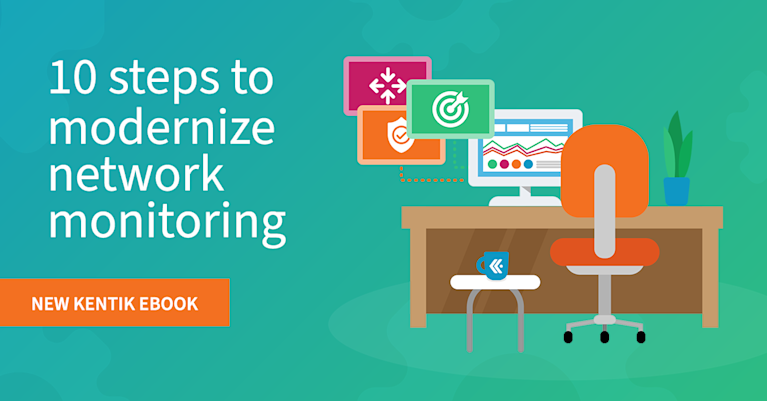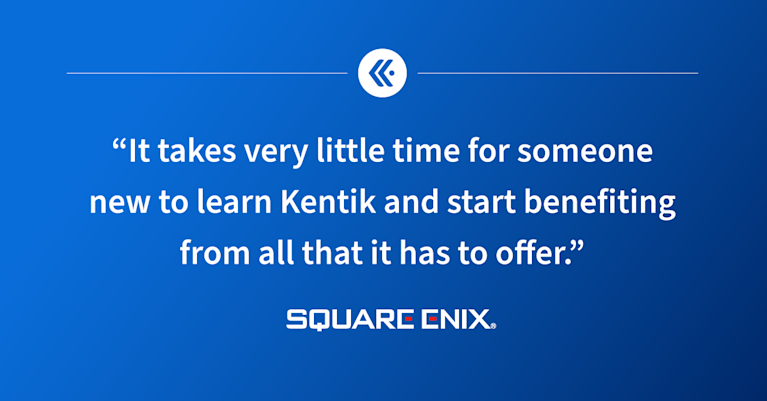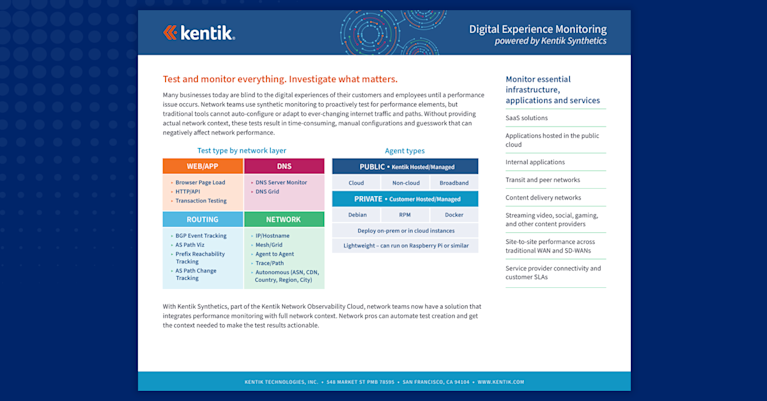What is Digital Experience Monitoring?
Digital Experience Monitoring (DEM) is a specialized performance analysis technique that focuses on enhancing the overall user experience in relation to enterprise applications and services, whether on-premises or in the cloud. By providing insights into the end-user experience across the “omnichannel user journey” –- a term coined by Gartner to describe the diverse ways users interact with applications –- DEM supports the continuous improvement and optimization of both human and machine interactions with digital tools, ultimately boosting productivity and efficiency.
Why is Digital Experience Monitoring Important?
Application developers are beginning to recognize DEM’s value to the end-user experience. For this reason, many DevOps teams are building in APIs early in the software development life cycle as part of the testing process of new releases. These APIs allow DEM systems to properly measure the performance of the end-user experience and the underlying application components. These more modern DEM solutions are especially sought after by infrastructure and operations leaders because they want to use DEM to regain insight into the performance of applications as they migrate to the cloud.
Network engineers also recognize the value of DEM. The performance of the network directly impacts the digital experience of application users. For this branch of DEM, synthetic traffic is generated to proactively measure network performance for packet loss, latency, and jitter.
Since DEM can measure the performance from the user’s point of view, the data collected can help uncover the impact that degraded performance can have on the business. We’re talking about everything from revenue generation to brand reputation and customer loyalty.
Advantages of Digital Experience Monitoring
Digital Experience Monitoring (DEM) provides several advantages to enterprises that adopt it. One of the most significant advantages of DEM is the ability to improve the end-user experience. By monitoring end-user experience, organizations can quickly identify and address performance issues that impact customer experience and satisfaction. This ability can lead to better business outcomes, including increased revenue, customer retention, and brand reputation.
Another advantage of DEM is its ability to identify performance issues across digital processes. DEM solutions can monitor application performance and web security, enabling organizations to quickly identify and resolve problems impacting digital business initiatives. Additionally, DEM solutions can provide insights into the performance of third-party applications and services, allowing organizations to hold vendors and service providers accountable for their performance and availability.
Finally, DEM can also help organizations create better business outcomes by providing a comprehensive view of network and application performance. Organizations can identify trends and make data-driven decisions to improve the end-user experience, reduce costs, and increase customer satisfaction by analyzing the data collected through DEM.
The Primary Components of Digital Experience Monitoring
There are three primary technology components that make up DEM:
Synthetic Monitoring / Synthetic Transaction Monitoring (STM)
Synthetic monitoring uses agents to proactively test services such as SaaS applications like Salesforce and API endpoints. Unlike Real User Monitoring (described below), STM isn’t generally run against active users, although it could be. Instead, its mission is usually intended to test the hosted or SaaS application (e.g., Salesforce, Office 365).
Synthetic monitoring techniques typically involve running a mix of HTTP commands (POST, GET, PUT, or DELETE) on a regular and periodic basis. However, deeper testing can also be done on connection times and database query speeds. Depending on the synthetic monitoring solution in use, the frequency of such testing can vary from daily, hourly, or even down to one-second intervals.
Synthetic monitoring can also be used to understand a website’s or web application’s performance in terms of specific user interactions with that site. This type of Digital Experience Monitoring is often termed “Synthetic Transaction Monitoring”. Learn more about these techniques in our Kentipedia article, “What is Synthetic Transaction Monitoring (STM)?”.
Metrics on response times, packet loss, jitter, and transaction times are gathered and sent off to the DEM collection platform, where correlations are performed. With integrated DEM and NPMD (Network Performance Monitoring and Diagnostics), tests can be performed across different forms of telemetry like NetFlow, sFlow, VPC logs, and even SNMP counters. AIOps techniques can be applied to get deeper insights as to why there is an application performance problem.
Endpoint Monitoring
Endpoint Monitoring provides visibility into the user devices and performance testing from the endpoint. This includes things like the version of the operating system, CPU and memory usage, storage space, and network metrics. While it can seem similar to desktop inventory software, the focus is on continued performance and availability.
Real User Monitoring
Real User Monitoring (RUM) monitors and measures the end-user experience when using the applications the business depends on. These applications include things like customer relationship management (e.g., Salesforce), collaboration tools (e.g., Slack, Microsoft Teams), and social media platforms (e.g., YouTube, Facebook). RUM uses application-based monitoring (usually JavaScript) or browser plugins to look at the actual performance that users are experiencing. Usually, this is available on a per-transaction basis and includes telemetry on bottlenecks that may be due to browser CPU or RAM overload.
Digital Experience Monitoring Use Cases
DEM and synthetic monitoring technologies can be applied to solve various application and network infrastructure problems, reduce costs, and improve visibility into network and application performance. Key use cases include:
- Finding and fixing application or network issues before they impact users.
- Benchmarking and baselining the performance of applications, APIs, websites, and networks across various variables, such as performance across different time-frames and geographies or performance against peers or industry standards.
- Holding vendors and service providers accountable by monitoring performance and availability versus SLAs (service level agreements).
- Preparing for significant network transitions, such as adding a new geographic market to a service offering or moving an existing data center to the cloud.
- Ensuring the performance of one’s own service offerings is adhering to customer SLAs, and providing regular reporting on performance versus such SLAs.
Digital Experience Monitoring and Synthetic Monitoring Agents
Synthetic tests conducted by a DEM solution will ideally be performed from multiple geographic locations to identify problems with specific network links and understand performance metrics concerning users in different regions.
For example, Kentik has built out a global network of synthetic testing agents that customers use to verify performance levels of all major public or private cloud-based applications and SaaS applications. These agents have been located inside Amazon Web Services, Google Cloud Platform, Microsoft Azure, Alibaba Cloud, and IBM Cloud, and these vantage points keep growing.
Challenges of Digital Experience Monitoring
Despite the many benefits of Digital Experience Monitoring, several challenges are associated with implementing a DEM strategy. One of the biggest challenges is the mix of technologies that DEM solutions rely on. To get a complete picture of their digital experience, organizations need to pull data from a variety of sources, including synthetic monitoring, real-user monitoring, and end-user experience monitoring. This sometimes requires a complex technology stack that can be challenging to manage.
Additionally, the challenge of pulling the right data to get a complete picture of their digital experience can be a significant obstacle. DEM solutions need to be able to collect data on user behavior across multiple devices, applications, and networks, which can be difficult to achieve without the right tools in place. Furthermore, analyzing and interpreting the collected data can be daunting, as it requires expertise in multiple areas, including network performance monitoring, application performance monitoring, and web security.
Ideal DEM solutions help solve these challenges while incorporating all the necessary DEM capabilities. They should provide a unified platform that can integrate seamlessly with existing technology stacks and provide actionable insights into the digital experience. Additionally, they need to provide easy-to-use analytic capabilities that allow users to easily access the data they need to make informed decisions. By addressing these challenges head-on, organizations can fully leverage the benefits of DEM to improve their digital processes and enhance the end-user experience.
Types of Digital Experience Monitoring (DEM) Tools
Digital Experience Monitoring (DEM) tools are essential for organizations seeking to optimize the end-user experience and improve overall digital performance. By providing insights into the user’s interactions with applications, services, and networks, DEM tools empower businesses to make informed decisions and enhance their digital offerings. A wide range of tools are available, each with unique features and DEM capabilities designed to address specific digital monitoring needs. Here are some of the most common types of Digital Experience Monitoring tools:
Synthetic Monitoring Tools
Synthetic monitoring tools simulate user interactions with applications, websites, and APIs to proactively test their performance and availability. By creating synthetic transactions, these tools can identify potential bottlenecks and issues before they impact real users. Synthetic monitoring tools are valuable for identifying potential problems in the application environment, as well as for benchmarking and comparing performance across different regions, devices, or network conditions.

Real User Monitoring (RUM) Tools
Real User Monitoring tools collect data on actual user interactions with applications and services, providing insights into how real users experience the digital environment. RUM tools use JavaScript-based monitoring or browser plugins to track user behavior and gather performance metrics, including page load times, transaction times, and user interactions. These tools are essential for identifying areas of improvement and optimizing end user experience based on real-world data. This category of digital experience monitoring solutions is sometimes called End User Experience Monitoring (EUEM).
Endpoint Monitoring Tools
Endpoint monitoring tools focus on the performance and availability of user devices, such as desktops, laptops, and mobile devices. These tools gather data on system performance, including CPU and memory usage, storage capacity, and network connectivity, to identify potential issues that may impact the end-user experience. Endpoint monitoring tools can help organizations ensure their devices are properly configured and optimized for the best possible digital experiences.
Application Performance Monitoring (APM) Tools
Application Performance Monitoring tools provide in-depth insights into the performance and health of applications and their underlying infrastructure. APM tools collect and analyze data on application performance, including response times, error rates, and resource utilization, to help identify and resolve issues that may impact the end-user experience. By integrating with other DEM tools, APM solutions can offer a comprehensive view of the digital experience, enabling organizations to optimize their applications and infrastructure.
Network Performance Monitoring and Diagnostics (NPMD) Tools
NPMD tools focus on the performance and health of networks, analyzing data on network traffic, latency, packet loss, and other key performance indicators. NPMD tools can help organizations identify and resolve network-related issues that may impact the end-user experience by providing insights into the network environment. NPMD tools are often used with other DEM tools, such as synthetic monitoring and RUM, to give a complete picture of the digital experience.
When selecting the right Digital Experience Monitoring tools for your organization, it’s crucial to consider your unique needs, infrastructure, and goals. By choosing the appropriate combination of DEM tools, businesses can effectively monitor, analyze, and optimize their digital environments, leading to improved end-user experiences, enhanced customer satisfaction, and better business outcomes.
Evaluating Digital Experience Monitoring Tools for Your DEM Strategy
When evaluating potential Digital Experience Monitoring (DEM) tools, IT operations teams should look for solutions that offer the following components:
- End-to-end visibility: DEM solutions should provide full visibility into the end-user experience across all applications, including web and mobile applications and endpoints.
- Real-time monitoring: DEM tools should provide real-time monitoring of user behavior and performance data to detect and troubleshoot issues as they occur.
- Synthetic and real user monitoring: Both synthetic transaction monitoring and real user monitoring are important components of DEM. Synthetic monitoring allows for proactive testing of applications and networks, while real user monitoring (or end user experience monitoring) provides insights into actual user behavior and experience.
- Analytics and reporting: DEM solutions should provide analytics and reporting capabilities to help IT teams identify performance issues and optimize application and network performance.
- Seamless integration: DEM solutions should seamlessly integrate with existing IT infrastructure and tools, such as APM and DevOps monitoring solutions.
About Kentik’s Digital Experience Monitoring Solution
The Kentik Network Intelligence Platform offers a modern, SaaS-based digital experience monitoring solution. Kentik delivers network performance monitoring and diagnostics that combine flow-based monitoring, cloud network observability and synthetic monitoring features to enable for proactive monitoring of all types of networks.

Kentik Synthetics is an autonomous, context-aware synthetic monitoring tool that enables businesses to measure the end-user experience from anywhere in the world. With hundreds of strategically positioned global agents in internet cities worldwide and in every cloud region within AWS, Google Cloud, and Microsoft Azure, Kentik Synthetics lets network teams automate test creation and get the context needed to make test results actionable. Autonomous tests allow testing towards a higher-level entity, and IP addresses are determined automatically based on actual network traffic. Kentik’s BGP monitoring lets businesses see BGP announcements and withdrawal events, paths taken, and get alerted to hijacks, reachability issues, and path changes. Kentik’s simple pricing offers more testing at a lower cost, with 2.5M credits per month for Kentik Pro customers and 5M credits per month for Kentik Premier customers.
Request a demo or start a free trial to try it yourself.


